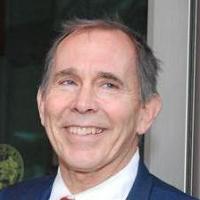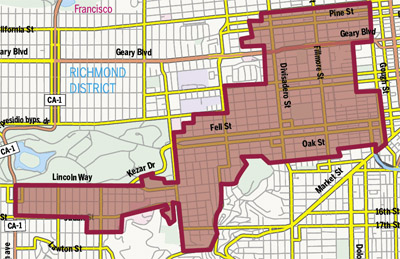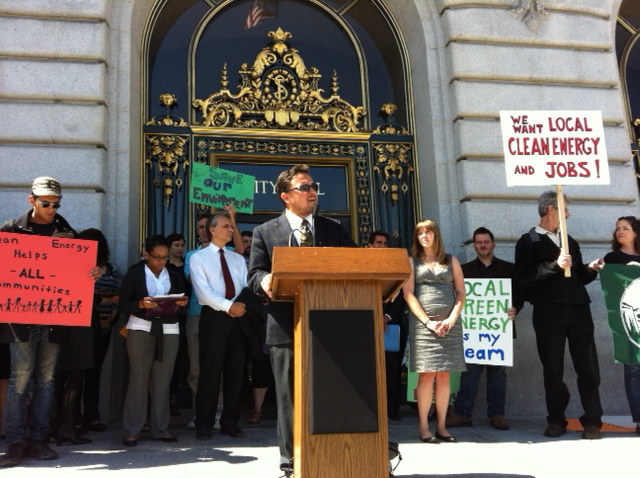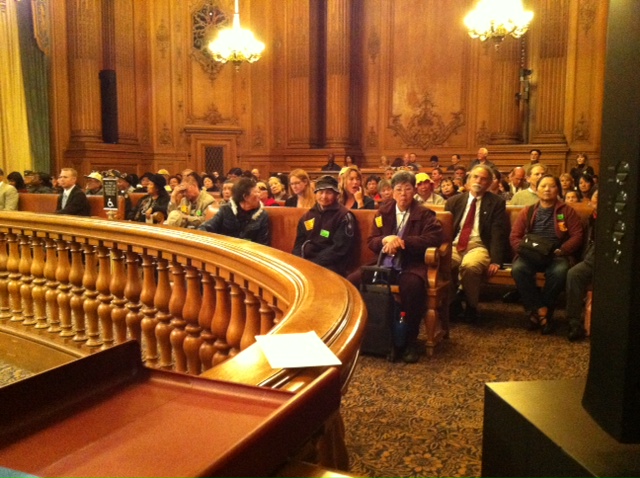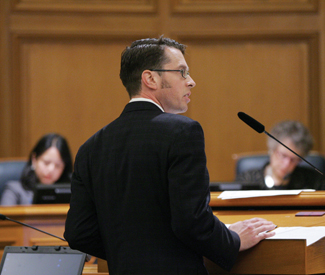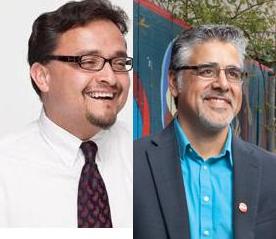WEDNESDAY 26
Amanda Palmer and the Grand Theft Orchestra
Massachusetts singer-songwriter Amanda Palmer has had a busy year. Well, actually she’s had a busy career. Palmer is a previous high school thespian, street performer, co-founder of the Dresden Dolls, subject of a coffee table book, half of musical duo Evelyn Evelyn, and a prolific blogger — and she’s just getting started. This year alone she’s written a song and produced a music video in defense of pubic hair, starred in a Flaming Lips video, released a new solo album, and now she’s back on the road. When Palmer decided to fund her second solo album Theater is Evil on Kickstarter earlier this year, few would have guessed over $1 million would pour in, shattering the site’s record with more than 24,000 individual donations. It looks like she won’t be slowing down any time soon. (Haley Zaremba)
With The Simple Pleasure, Jherek Bischoff, Ronald Reagan
8pm, $25
Fillmore
1805 Geary, SF
(415) 346-3000
Ghost Parade
Over the past six months, San Francisco-based progressive rock band Ghost Parade has steadily revealed its inaugural tracks, including the particularly catchy “Reach,” whose chorus features the group’s tagline: “we are fast and real.” Intense at times and always poetic, Ghost Parade encourages you to get lost in its hard and fast wall of sound while, simultaneously, inviting you into its stories. These musicians are no strangers to Bottom of the Hill, but this time around they’re headlining. Come for the energy, come for the nascent artistic merriment and, if that’s not enough, come for vocalist-guitarist Justin Bonifacio’s hair. It ranks among the best in San Francisco. Hands down. (Mia Sullivan)
With Stomacher, Soonest
9pm, $10
Bottom of the Hill
1233 17th St., SF
(415) 626-4455
Obituary
It may be hard to believe, but pioneering death metal titan Obituary has been grinding out tracks such as “Chopped In Half” and “Turned Inside Out” for more than 25 years now. The Florida based quartet just wrapped up a series of festival shows in Europe, and is now back for its first tour of the US in several years, part of the epic Carnival of Death tour, slaying stages alongside Broken Hope, Decrepit Birth, Jungle Rot, Encrust, and Feast. The band is promising a fan-favorite set, comprised largely of songs off of its first three classic albums, Slowly We Rot, Cause of Death, and The End Complete. (Sean McCourt)
With DJ Rob Metal
6:30pm, $14–$18
DNA Lounge, 375 11th St., SF.
(415) 626-1409
THURSDAY 27
“Shocktoberfest 13: The Bride of Death”
The Thrillpeddlers have been killing it lately, with endlessly extended runs of Cockettes revivals and a recent hit production of Marat/Sade. Now the company is poised to kill it again — live! Onstage! With gruesome gore! — in its annual “Shocktoberfest” production. This year’s lucky 13th incarnation includes a classic Grand Guignol one-act (Coals of Fire by Fredrick Whitney, which caused a scandal in 1922 Britain); two contemporary world premieres about mad scientists (The Bride of Death by Michael Phillis and The Twisted Pair by Rob Keefe); and Scrumbly Koldewyn’s “musical spectacle” Those Beautiful Ghouls. And if you think you’re safe just sitting in the audience, wait until the uniquely terrifying spook-show finale — if you’re not afraid of the dark, you will be! (Cheryl Eddy)
Through Nov. 17
Opens Thu/27, 8pm; runs Thu-Sat, 8pm, $25-35
Hypnodrome
575 10th St., SF
FRIDAY 28
“Animate Your Night: Where It’s AT-AT”
As part of the Walt Disney Family Museum’s new “Animate Your Night” series of after-hours events, tonight’s “Where It’s AT-AT” party celebrates the opening of a new exhibit, Between Frames: The Magic Behind Stop Motion Animation, which looks at the innovative ideas and technical wizardry of the art form that has brought life to a host of magical characters and creations. Among the items party-goers will be able to get a first look at is a classic Gumby figure, the armature of the “Robot Chicken” mascot, and a model of the awesome AT-AT Imperial Walker made by Phil Tippett, as seen in The Empire Strikes Back. (McCourt)
7-10pm, $5–$10
Walt Disney Family Museum
104 Montgomery, SF
(415) 345-6800
Vir
While “on” Vir, I can’t decide if I’d rather take mass quantities of psychedelics and, well, gaze at my shoes, or embark on an epic, intergalactic quest with a few of my closest tribesmen. Luckily, these options aren’t mutually exclusive. This Oakland-based experimental noise pop trio originally hails from New Zealand and cites Kiwi post-punk groups Gordons, Bailter Space, and HDU as chief influences. Characterized by driving, tribal beats, sardonic, echoing lyrics, and ample fuzz pedal, Vir’s music is, at times, like marching through a lush jungle-like space field and, at other times, like My Bloody Valentine. Could it get much better? (Sullivan)
With Here Come the Saviours, Erik Blood
9:30pm, $7
Hemlock
1131 Polk, SF
(415) 923-0923
SATURDAY 29
Balboa Skatepark opening ceremony
Shredding (on a skateboard) and shredding (with a guitar) go together like pizza and hot dogs — which, incidentally, there will be a whole lot of at the Balboa skateboard park opening this week. While skaters grind their newly opened park behind, local thrasher act Haunted By Heroes — a.k.a. the world’s youngest rock band — along with the Nerv, and Big Shadows will perform out front. Plus, the free event includes the aforementioned ultimate snack foods, skateboard accessory giveaways, and the Youth DJ Collective with DJ/MC Ace, of Reality Check TV. Make like the ramp locals of Thrashin’ (1986) and bring your board, check out frenetic live music, munch cheesy pizza, and relive youth, glorious youth. (Emily Savage)
Noon-5pm, free
Balboa Skatepark
San Jose Avenue and Ocean Avenue, SF
Facebook: BalboaSkateparkOpening2012
Vintage Couture Ball
Let’s hear it for the grown and sexy. While the rest of us drink beer and chug from flasks in the bathroom, they drink Manhattans (up) and sip from nicer flasks, out in the open because unlike some, the motion only serves to make their surroundings more G&S. Class it up and join their ranks for this weekend’s openair fashion gala in the Fillmore — the Vintage Couture Ball (once called the Black Couture Ball) brings Chicago step dancing, a vintage car show, burlesque and swing dancing to SF’s jazz district. Most importantly, heed the dress code — everyone’s fancy black gowns and suits should make the evening pop. (Caitlin Donohue)
7pm-1am, $20
Fillmore between Eddy and Geary, SF
(800) 352-4315
SUNDAY 30
Hot Water Music
It’s been an exciting year for post-hardcore. It marks the release of industry pioneer Hot Water Music’s first album in nearly a decade and the 19th anniversary since the band’s foundation in 1993. In these two decades, the band has broken up and reunited three different times, taking years off to explore side projects and family life. Though it has been touring sporadically since 2008, the Gainseville band’s eighth album Exister truly marks its triumphant return to the rock scene. The first single off the album, “State of Grace,” tackles the issue of the additives that we ingest every day in our over-processed foods. Whether you care about GMOs or not, you’ll want to catch this tour before Hot Water Music disbands again. (Zaremba)
With Dead To Me, Heartsounds
8pm, $21
Slim’s
333 11th St., SF
(415) 255-0333
Bebel Gilberto
New York City and Rio de Janeiro are a potent combination. As proof, we offer you Bebel Gilberto, daughter of famed bossanova boss João Gilberto and international star in her own right. Bebel’s 2009 release All in One relies less heavily on the electronic bends and flourishes of her past, its mainly acoustic, gentle guitar strums and chimes behind Brazilian coos. In other words, go to this concert to lower your blood pressure, it will smooth you out. In fact, we’d be hard pressed a better soundtrack to your weekend comedown, or swayfest with that new boo you picked up on last night’s dancefloor. (Donohue)
7pm, $35-70
Herbst Theater
401 Van Ness, SF
Maria Minerva
Like a ’90s TRL countdown as envisioned by Peaking Lights, Maria Minerva’s fuzzed-out hypnagogia is the stuff of bygone pop anthems, filtered experimentally and relentlessly through Macbooks, cheap software, and a boatload of filters and effects. Commended by The Wire for her contribution to the blossoming meta-pop movement, the elusive Estonian producer strikes a captivating balance between high art and radio trash, traditional top-40 conventions and anarchic nonconformity. Minerva’s newly released Will Happiness Find Me? might be her most accessibly structured statement yet, but that doesn’t stop her dubby sonic fog from enshrouding everything in its path. Fans of electronic hooliganism everywhere: meet your new pop diva. (Taylor Kaplan)
With Father Finger, Bobby Browser, EpicSauce DJs
8pm, $12
Rickshaw Stop
155 Fell, SF
(415) 861-2011
MONDAY 1
Garbage
When it first arrived on the alternative rock scene back in the mid ’90s, Garbage could have been some sort of pre-fabricated hit machine, considering its members consisted of some of the biggest producers of the time — Butch Vig, Steve Marker, and Duke Erikson — with ex-Angelfish singer Shirley Manson joining the fold. As fans know, however, it quickly became evident that they were much more than that, a band that coalesced as one and produced some of the most memorable tunes of the era. After a series of hiatuses, the quartet is back with an excellent new album, Not Your Kind of People, and a welcome return to the live stage. (McCourt)
With Screaming Females
8pm, $38–$48
Warfield
982 Market, SF
(415) 345-0900
The Guardian listings deadline is two weeks prior to our Wednesday publication date. To submit an item for consideration, please include the title of the event, a brief description of the event, date and time, venue name, street address (listing cross streets only isn’t sufficient), city, telephone number readers can call for more information, telephone number for media, and admission costs. Send information to Listings, the Guardian, 225 Bush, 17th Flr., SF, CA 94105; or e-mail (paste press release into e-mail body — no attachments, please) to listings@sfbg.com. Digital photos may be submitted in jpeg format; the image must be at least 240 dpi and four inches by six inches in size. We regret we cannot accept listings over the phone.

